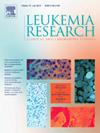Parous female donor is not inferior to the young male donor under the low-dose ATG/PTCy combination-based regimen for GVHD prophylaxis in haploidentical peripheral blood stem cell transplantation
IF 2.1
4区 医学
Q3 HEMATOLOGY
引用次数: 0
Abstract
Background
An optimal donor is critical for patient survival undergoing haploidentical hematopoietic stem cell transplantation (haplo-HSCT). The impacts of different donors on outcomes under the combination regimens of anti-thymocyte globulin (ATG) and post-transplant cyclophosphamide (PTCy) for graft-versus-host disease (GVHD) prophylaxis had limited data. Methods: Therefore, a single-center retrospective study was performed for patients undergoing haploidentical peripheral blood stem cell transplantation (haplo-PBSCT) with ATG/PTCy combination-based regimen. Results: The donors were divided into young male (age <30 years, n = 74), non-parous female (age <30 years, n = 22), older male (age ≥30 years, n = 117), and parous female (age ≥30 years, n = 42) donor groups. The cumulative incidences (CIs) of acute and chronic GVHD, and survival outcomes were similar between the 4 groups (P > 0.050), while the parous female donor could significantly reduce the cumulative incidence of relapse (CIR). Conclusions: The results showed that the parous female donor could significantly reduce CIR and might improve survival under the ATG and PTCy combination-based GVHD prophylaxis regimen after haplo-PBSCT.
在单倍体外周血干细胞移植中,低剂量ATG/PTCy联合治疗预防GVHD的效果不逊于年轻男性
背景:选择合适的供体是单倍体造血干细胞移植(haploi - hsct)患者存活的关键。在抗胸腺细胞球蛋白(ATG)和移植后环磷酰胺(PTCy)联合治疗移植物抗宿主病(GVHD)预防方案下,不同供体对预后的影响数据有限。方法:因此,对接受单倍体外周血干细胞移植(haploo - pbsct)并采用ATG/PTCy联合方案的患者进行单中心回顾性研究。结果:供体分为年轻男性(年龄<;30岁,n = 74)、未生育女性(年龄<;30岁,n = 22)、老年男性(年龄≥30岁,n = 117)、已生育女性(年龄≥30岁,n = 42)供体组。四组间急性、慢性GVHD的累积发生率(CIs)及生存结局相似(P >; 0.050),而生育女性供体可显著降低累积复发发生率(CIR)。结论:结果显示,单倍pbsct后,ATG和PTCy联合预防GVHD方案下,已生育的女性供体可显著降低CIR,提高生存率。
本文章由计算机程序翻译,如有差异,请以英文原文为准。
求助全文
约1分钟内获得全文
求助全文
来源期刊

Leukemia research
医学-血液学
CiteScore
4.00
自引率
3.70%
发文量
259
审稿时长
1 months
期刊介绍:
Leukemia Research an international journal which brings comprehensive and current information to all health care professionals involved in basic and applied clinical research in hematological malignancies. The editors encourage the submission of articles relevant to hematological malignancies. The Journal scope includes reporting studies of cellular and molecular biology, genetics, immunology, epidemiology, clinical evaluation, and therapy of these diseases.
 求助内容:
求助内容: 应助结果提醒方式:
应助结果提醒方式:


